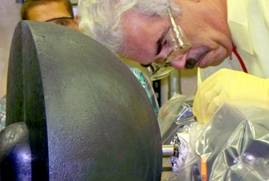Friday, November 30, 2012
Proposed nuclear reactor could power future space flights
Nuclear powered deep space probe. LANL illustration.
A team of NASA and Department of Energy researchers has shown that a reliable nuclear reactor based on technology that's been around for decades could be used in spaceships, according to a news release from the Los Alamos National Laboratory, where some of the researchers are based.
Stirling engines, which were initially developed in the 19th century, are relatively simple, closed-loop engines that convert heat energy into electrical power using a pressurized gas to move a piston. (Full Story)
Los Alamos Lab demonstrates a reactor for space travel
Prototype nuclear space engine. LANL image.
For spacecraft, you really can’t beat the efficiency and simplicity of a nuclear power supply. From the Pioneer probes to the Mars rover Curiosity, a nuclear battery allows a slow drip of electricity where solar power would be impractical or impossible.
The nuclear engineering wizards at Los Alamos National Laboratory have an alternative: Uranium-powered nuclear fission reactors that convert heat into electricity. (Full Story)
Scientists test novel power system for space travel
John Bounds of Los Alamos National Laboratory's Advanced Nuclear Technology Division makes final adjustments on the DUFF experiment. LANL photo.
The research team recently demonstrated the first use of a heat pipe to cool a small nuclear reactor and power a Stirling engine at the Nevada National Security Site's Device Assembly Facility near Las Vegas. The Demonstration Using Flattop Fissions (DUFF) experiment produced 24 watts of electricity. A team of engineers from Los Alamos, the NASA Glenn Research Center and National Security Technologies LLC (NSTec) conducted the experiment. (Full Story)
This story also appeared in many other news outlets including the Albuquerque Journal, Wired Magazine, New Mexico Business Weekly, and the Daily Mail
Cobalt could replace precious metals as industrial catalyst
Artwork depicts the substitution of cobalt for precious metals in catalysis. LANL illustration.
Cobalt, a relatively common mineral, may hold promise as an industrial catalyst with potential applications in such energy-related technologies as the production of biofuels and the reduction of carbon dioxide.
In the international edition of the chemistry journal Angewandte Chemie, Los Alamos National Laboratory scientists report the possibility of replacing the normally used noble metal catalysts with cobalt. (Full Story)
This story also appeared in PhysOrg
The next frontier of disease prevention
Hong-Gellar. New Mexican Photo.
Elizabeth Hong-Geller, a bioscience investigator at Los Alamos National Laboratory, is exploring ways to translate recent insights into the fundamental genetic structure of the cell and put the so-called “useless” or “junk DNA” to work as a line of defense against infectious diseases.
“There have been some drugs made post-2000 but they haven’t turned out to be as effective, and as a result they haven’t replaced the older drugs,” said Hong-Geller. “We wanted to try to figure out some other biological models we could use as a target for drug development.” (Full Story)
How climate change could affect entire forest ecosystems
Droplets caused by fog collect on the needles of this Bishop pine tree on Santa Cruz Island. Photo by Mariah Carbone.
"The finding that summer fog strongly impacts carbon cycling highlights the need for improved understanding of whether we should expect coastal summer cloud behavior to change in a warmer world," said co-author A. Park Williams of Los Alamos National Laboratory.
"A change in summer fogginess could produce temperature, moisture, and carbon feedbacks in coastal ecosystems that easily swamp out the effects expected from increased greenhouse gases alone," said Williams. (Full Story)
Thermal imaging takes on color
U.S. Army photo.
The University of New Mexico is creating a new generation of chips for infrared cameras that could change today’s black-and-white thermal images to color.
That could greatly enhance the ability of infrared imaging to detect and distinguish things, improving their use in medical, industrial and military applications. Collaborators include Raytheon, Los Alamos and Sandia. (Full Story)
Los Alamos site office manager promoted
Kevin Smith.
The National Nuclear Security Administration and the federal Office of Environmental Management have promoted the manager of the Los Alamos Site Office.
Kevin Smith will become the manager of the Office of River Protection, where he will focus on technical issues related to high-level waste, and other contaminants, in Washington State. (Full Story)
Climber takes precautions on trips
Jason Halladay - Los Alamos Mountaineers Photo.
Jason Halladay climbed to within 3,000 feet of the summit of Mount McKinley (Denali) last June with the plan of snowboarding down the side of the mountain. When he got to an elevation of 17,200 feet and realized that trail conditions prevented him from going any further, he re-evaluated his plan to snowboard down the mountain… Halladay, a 38-year old systems administrator at Los Alamos National Laboratory who lives in Los Alamos, has climbed all 59 14,000-foot-plus mountains in Colorado twice in the past decade during all seasons of the year. (Full Story)
To subscribe to Los Alamos Report, please e-mail listmanager@lanl.gov and include the words subscribe losalamosreport in the body of your email message; to unscubscribe, include unsubscribe losalamosreport.
Please visit us at www.lanl.gov
And follow us on Facebook, Twitter, YouTube, and Flickr


















